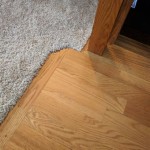How to Install Vinyl Plank Flooring In Basement
Installing vinyl plank flooring in your basement can be a great way to add value and style to your home. Vinyl plank flooring is durable, waterproof, and easy to clean, making it a great choice for basements. Here are the steps on how to install vinyl plank flooring in your basement. ### Tools and Materials * Measuring tape * Level * Utility knife * Tapping block * Vinyl plank flooring * Underlayment (optional) * Transition strips (optional) ### Step 1. Preparation Start by preparing your basement for the flooring installation. Remove any existing flooring, baseboards, and trim. Then, clean the subfloor and make sure it is level. If the subfloor is not level, you will need to level it using a self-leveling compound. ### Step 2. Install Underlayment Underlayment is a thin layer of material that is installed between the subfloor and the vinyl plank flooring. Underlayment helps to reduce noise and insulate the floor. If you are installing vinyl plank flooring in a basement, it is a good idea to use an underlayment that is moisture-resistant. ### Step 3. Lay Out the Vinyl Plank Flooring Once the underlayment is installed, you can start to lay out the vinyl plank flooring. Start by measuring the length and width of the room. Then, divide the length of the room by the length of the vinyl planks to determine how many rows you will need. Lay out the first row of vinyl planks along one of the walls. Make sure that the planks are flush with the wall and that there is a gap of about 1/4 inch between the planks and the wall. ### Step 4. Install the Vinyl Plank Flooring Once the first row of vinyl planks is laid out, you can start to install the rest of the planks. Tap the planks together using a tapping block. Make sure that the planks are level and that there are no gaps between the planks. Continue installing the vinyl plank flooring until you reach the other side of the room. Once the flooring is installed, you can trim any excess planks around the edges of the room. ### Step 5. Install Transition Strips If you are installing vinyl plank flooring in a room that has a different type of flooring, you will need to install transition strips. Transition strips are used to cover the gap between the two types of flooring. Measure the length of the gap between the two types of flooring. Then, cut the transition strips to the appropriate length. Install the transition strips using the manufacturer's instructions. ### Step 6. Finish the Installation Once the vinyl plank flooring is installed, you can finish the installation by installing baseboards and trim. Baseboards and trim help to cover the gaps between the flooring and the walls. Installing vinyl plank flooring in your basement is a great way to add value and style to your home. By following these steps, you can install vinyl plank flooring in your basement yourself.
Lvp Flooring Installation How To Install Luxury Vinyl Plank In A Basement Diy

Vinyl Plank Flooring On Concrete Basement Pros Cons

How To Install Vinyl Plank Flooring On Concrete Step By Guide

Vinyl Plank Flooring Installation Basement Remodel Before And After

Best How To Install Vinyl Plank Flooring Four Generations One Roof

Ep5 Finishing A Basement How To Install Vinyl Plank Flooring Diy

How To Install Vinyl Plank Flooring Rogue Engineer

Tips For Installing Vinyl Plank Over Concrete Floors Lemon Thistle

10 Beginner Mistakes Installing Vinyl Plank Flooring

How To Install Vinyl Plank Flooring On Concrete Step By Tutorial








